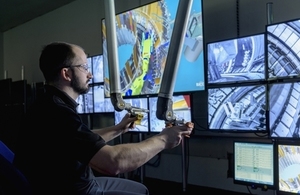RACE to host €10m ITER test facility
UKAEA announces collaboration with ITER Organization in remote handling

RACE remote handling
The UK Atomic Energy Authority (UKAEA) and the ITER Organization have entered into a technical collaboration which will see the UKAEA’s centre for Remote Applications in Challenging Environments, RACE, host the ITER Remote Handling Test Facility (IRTF) for a period of at least five years.
The UK Government is investing €5 million over this period, matched by the ITER Organization, to perform testing of critical remote handling operations necessary for the maintenance of components for ITER – the international fusion energy project based in Cadarache, France.
The IRTF will be used to test and evaluate remote handling system designs, conduct remote handling trials of generic and specific maintenance tasks and thus demonstrate the feasibility and compatibility of these remote handling tasks and to provide operational feedback into the final component designs. Test facilities will be established across many of the ITER systems, including Diagnostics, Heating, Vacuum and Port Plugs. UKAEA’s RACE centre, at Culham Science Centre near Oxford, is actively supporting a number of industry-led partnerships developing remote maintenance systems for the ITER project, including the Divertor, Neutral Beam and the Cask & Plug Remote Handling System. Having this common link provides the opportunity for sharing best practice, creating common standards, sharing development effort and the development of generic test facilities.
UKAEA Head of Business Development, Martin Townsend, explained:
UKAEA remains committed to the realisation of ITER, helping to support industry to secure business from the ITER programme and partnering with all stakeholders to deliver the new technologies and processes necessary for success. Hosting the ITER remote handling test facility provides an excellent opportunity to link UKAEA’s know-how with ITER Organization technical experts, supported by industry.
The ITER Organization’s Division Head for Remote Handling & Radioactive Materials, Spencer Pitcher, summarised the win-win nature of the collaboration:
At the RACE centre, we now have access to an excellent new facility at a fusion laboratory dedicated to remote handling and staffed with expertise arising from long experience in performing such tasks on the JET fusion experiment. Meanwhile at ITER, we are in the midst of designing components that will require remote maintenance and for which validation of maintenance schemes by mock-ups can greatly reduce the risk to the ITER project. ITER itself will not have facilities on our premises to perform such tests for several years. This UKAEA contribution to the success of fusion and ITER makes an excellent match with ITER’s remote handling >mock-up and testing requirements.
Ends
For more information please contact Nick Holloway, UKAEA Media Manager, on 01235 466232 or email nick.holloway@ukaea.uk
Notes to Editors
RACE (Remote Applications in Challenging Environments) Part of the UK Atomic Energy Authority, RACE is conducting R&D and commercial activities in the field of Robotics and Autonomous Systems. Based at Culham Science Centre near Oxford, RACE offers access to test facilities, robotic equipment and expertise for SMEs, multinationals, research laboratories and academia from sectors with ‘challenging environments’ such as nuclear fission and fusion, petrochemical, space exploration, construction and mining. Further information: http://www.race.ukaea.uk
United Kingdom Atomic Energy Authority The UK Atomic Energy Authority (UKAEA) carries out fusion energy research on behalf of the Government at Culham Science Centre. It is also developing Culham as a location of hi-tech research and business, with around 40 tenant companies now on site and UKAEA’s new RACE robotics centre and Materials Research Facility, which both opened in 2016.
UKAEA’s fusion lab Culham Centre for Fusion Energy oversees Britain’s fusion programme, headed by the MAST Upgrade experiment. It also hosts the world’s largest fusion research facility, JET (Joint European Torus), which it operates for European scientists under a contract with the European Commission.
ITER ITER (“The Way” in Latin) is one of the most ambitious energy projects in the world today. At Cadarache in southern France, 35 nations are working together to build the world’s largest tokamak, a magnetic fusion device that has been designed to prove the feasibility of fusion as a large-scale and carbon-free source of energy based on the same principle that powers our Sun and stars. The work that will be carried out at ITER is crucial to advancing fusion science and preparing the way for the fusion power plants of tomorrow.
ITER will be the first fusion device to produce net energy. ITER will be the first fusion device to maintain fusion for long periods of time. And ITER will be the first fusion device to test the integrated technologies, materials, and physics regimes necessary for the commercial production of fusion-based electricity. The ITER Organization is an intergovernmental organization that was established by an international agreement signed in 2006. The Parties to the ITER Agreement (the ITER Members) are the People’s Republic of China; the European Atomic Energy Community (Euratom); the Republic of India; Japan; the Republic of Korea; the Russian Federation; and the United States of America. Further information: https://www.iter.org/